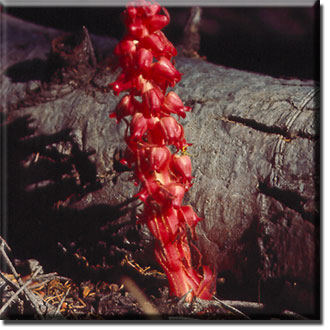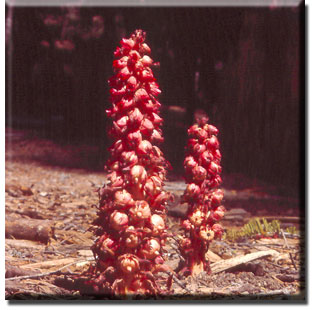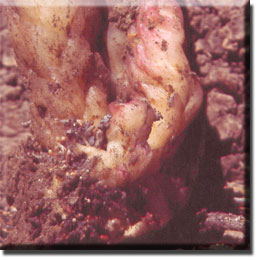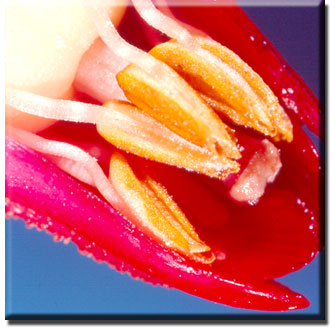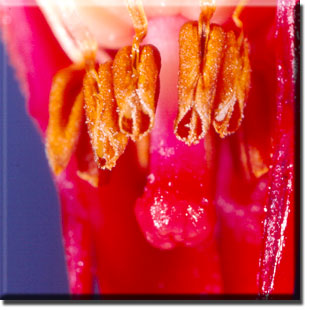Sarcodes sanguinea
There is a group of non-green flowering plants that is related to the heaths (blueberries, cranberries, rhododendrons) and is often included in the heath family (Ericaceae). This group of non-green plants is a subset of the heath family. Let's call them the monotropoids. Are they parasites? Yes, but in an unusual way. The monotropoids were thought to be "saprophytes." A saprophyte lives on dead plant or animal material, but the monotropoids don't do that. They are parasites on fungi, we can call them mycoparasites. But they don't kill the fungi. The fungi infect the short, stubby roots of the monotropoids, and transfer food and water into the roots. The fungi live in the dense litter of dead leaves in wet forests.
The most striking of the monotropoids is the snow plant, Sarcodes sanguinea. Sarcodes was called the snow plant because it was thought to come up through the snow. But it really doesn't--it comes up after the snow melts or has mostly melted. It grows in conifer forests of California, and portions of western Nevada and northern Baja California. Some plants of Sarcodes are brilliant red, others are more nearly rose-colored. Why the bright color? Nobody really knows. Such a bright color might attract pollinating insects in the rather shady forest floor areas where the snow plant grows. The flowers point downward. This plant has already formed some young fruits, lower on the stalk, although the youngest flowers, at the top of the stem, are still opening.
The underground portions of the snow plant are white. In this picture, you can se the tight cluster of short, knobby roots. The roots contain fungi which extend into the conifer forest leaf litter in which Sarcodes grows. The snow plant is fed water and nutrients from the fungi. These fungi also extend into the roots of pines and other conifers. Using radioactive carbon, one study showed that the sugars from the conifer roots enter the fungi and then are transferred into the roots of the snow plant. The flowers of Sarcodes point outward for a short time, then point downward. They open in a narrow tube. In front of this flower is one of the leaves of the snow plant. And we have the view looking into some open flowers of Sarcodes, the snow plant. 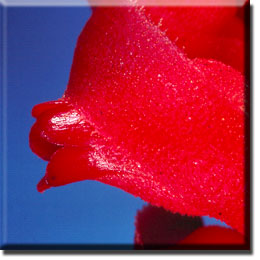 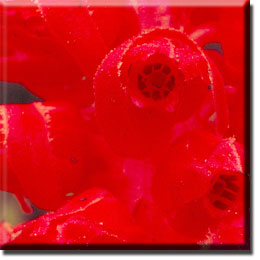 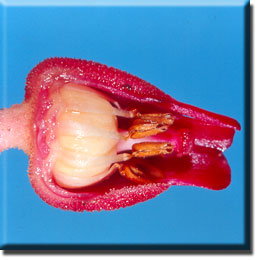
The inside of a snow plant flower. When the flower is cut open, the large white ovary, which will contain seeds when it mature, appears. The stamens, tan-color, contain pollen; and the sticky bright red surfaces of the stigma, which collects pollen, can easily be seen. A flower of the snow plant, cut open, reveals the stamens (yellow-brown) just opening to release pollen.
The stamens of this flower have finished shedding their pollen. The pollen escapes through the holes in the tips of the stamens. Does this flower look upside down? Remember, the flowers of the snow plant point downwards once they open. Stamens that open by holes instead of slits are often thought to release pollen when they shake. The vibrations of a visiting insect may cause such shaking. Part of a snow plant, Sarcodes, showing fruits developing. The fruits are colorful and fleshy at this stage, and might think that some fruit-eating animal might be attracted to them. However, when they are mature, the fruits of the snow plant are dry and shed fruits through slits in the fruit wall. A cross-section of a developing fruit of the snow plant. The seds are already brown, their color at maturity. The center of the fruit, however, is still white and fleshy. Seeds of the snow plant, greatly enlarged. They have rough surfaces. Nobody knows how they are dispersed from one place to another. In order to grow, they must become buried in the leaf litter of a conifer forest. Probably they need to contact particular fungi in order to germinate. The geographical range of the snow plant is probably limited by the extent of the conifers and the fungi that the snow plant depends upon. 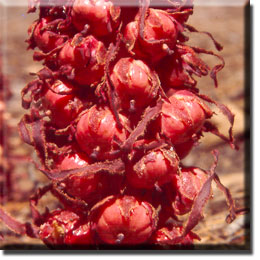 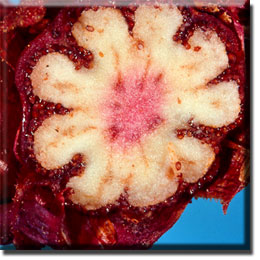 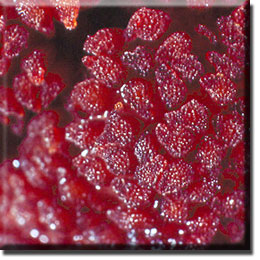 |
